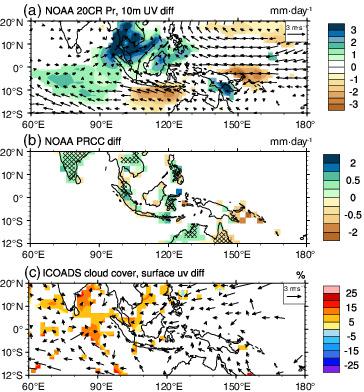当前位置:
X-MOL 学术
›
Int. J. Climatol.
›
论文详情
Our official English website, www.x-mol.net, welcomes your
feedback! (Note: you will need to create a separate account there.)
Strengthening western equatorial Pacific and Maritime Continent atmospheric convection and its modulation on the trade wind during spring of 1901–2010
International Journal of Climatology ( IF 3.5 ) Pub Date : 2020-09-30 , DOI: 10.1002/joc.6856 Zhenning Li 1 , Song Yang 2, 3 , Chi‐Yung Tam 1, 4 , Chundi Hu 2, 3
International Journal of Climatology ( IF 3.5 ) Pub Date : 2020-09-30 , DOI: 10.1002/joc.6856 Zhenning Li 1 , Song Yang 2, 3 , Chi‐Yung Tam 1, 4 , Chundi Hu 2, 3
Affiliation

|
Changes in the tropical atmospheric overturning circulation can strongly influence the global weather pattern via affecting the location, extent, and strength of tropical convective heating. However, due to limitations in obtaining reliable global data before the satellite era, there are still uncertainties on long‐term changes in the tropical overturning features, such as the Walker Circulation. By analysing the 20th century reanalysis products, ship‐based observations and gauge‐based land precipitation data, robust intensification of convection is found over the western equatorial Pacific and Maritime Continent (WEP‐MC; 90°E–150°E/15°S–15°N), where rainfall and total cloud cover increased by 15–20% in boreal spring during 1901–2010. The signal is noticeably seasonally dependent, and both rainfall and cloud cover show consistent and significant increasing trends only in the boreal spring season. General circulation model (GCM) experiments were conducted using two different reconstructed SST data sets as forcing; results from both runs indicate springtime intensification of WEP‐MC convection, even with relatively uniform SST warming. Further, numerical experiments using a simplified model show that the Pacific trade wind can be accelerated by intensifying cumulus heating; however, this can be sensitive to the location of convection, and only occurs if the latter is within ±5° in latitude along the equator. Our findings suggest that the secular change in the Walker Circulation is potentially discovered from the current reanalysis and observational data sets if “regional‐up” approaches are applied.
中文翻译:

1901-2010年春季,加强赤道西太平洋和海洋大陆对流及其对商风的调节
热带大气翻转循环的变化可以通过影响热带对流加热的位置,程度和强度,强烈影响全球天气模式。然而,由于在卫星时代之前获取可靠的全球数据的局限性,热带倾覆特征(如沃克环流)的长期变化仍存在不确定性。通过分析20世纪的再分析产品,基于船的观测数据和基于量规的土地降水数据,发现了赤道西太平洋和海洋大陆(WEP-MC; 90°E–150°E / 15°S)的强对流加剧–15°N),在1901–2010年期间,北方春季的降雨和总云量增加了15-20%。该信号明显取决于季节,仅在北方春季,降雨和云量都显示出持续且显着的增长趋势。使用两个不同的重建SST数据集作为强迫进行了通用循环模型(GCM)实验;两次运行的结果都表明,即使SST升温相对均匀,WEP-MC对流的春季强度也会增加。此外,使用简化模型进行的数值实验表明,可以通过增加积云加热来加速太平洋贸易风。但是,这对对流位置可能很敏感,并且仅在对流位置沿赤道的纬度在±5°以内时才会发生。我们的发现表明,如果采用“区域向上”方法,则沃克循环的长期变化可能是从当前的重新分析和观测数据集中发现的。
更新日期:2020-09-30
中文翻译:

1901-2010年春季,加强赤道西太平洋和海洋大陆对流及其对商风的调节
热带大气翻转循环的变化可以通过影响热带对流加热的位置,程度和强度,强烈影响全球天气模式。然而,由于在卫星时代之前获取可靠的全球数据的局限性,热带倾覆特征(如沃克环流)的长期变化仍存在不确定性。通过分析20世纪的再分析产品,基于船的观测数据和基于量规的土地降水数据,发现了赤道西太平洋和海洋大陆(WEP-MC; 90°E–150°E / 15°S)的强对流加剧–15°N),在1901–2010年期间,北方春季的降雨和总云量增加了15-20%。该信号明显取决于季节,仅在北方春季,降雨和云量都显示出持续且显着的增长趋势。使用两个不同的重建SST数据集作为强迫进行了通用循环模型(GCM)实验;两次运行的结果都表明,即使SST升温相对均匀,WEP-MC对流的春季强度也会增加。此外,使用简化模型进行的数值实验表明,可以通过增加积云加热来加速太平洋贸易风。但是,这对对流位置可能很敏感,并且仅在对流位置沿赤道的纬度在±5°以内时才会发生。我们的发现表明,如果采用“区域向上”方法,则沃克循环的长期变化可能是从当前的重新分析和观测数据集中发现的。











































 京公网安备 11010802027423号
京公网安备 11010802027423号